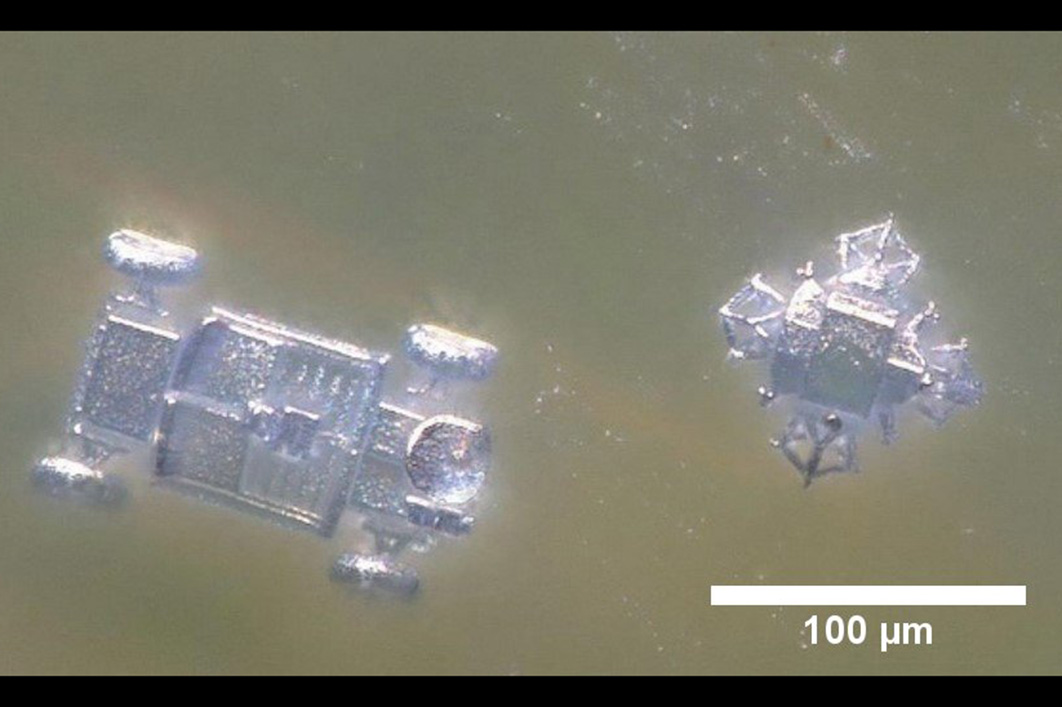
A transparent miniature rover and landsphere printed in ceramic with details measuring just a few micrometres.
Source: BAM
Ceramic micro- and nano structures are not producible with classic powder-slurries, because the particles scatter the light, which is essential for the structruring with high resolution AM-techniques. The research group around Dr.-Ing. Johanna Müller-Elmau utilizes transparent nano particle loaded feedstocks to develop ceramic components in the micrometer to centimeter range for e.g. medical and optical applications.
In Materials Engineering (Link) department the group can rely on expertise in additive manufacturing of ceramic parts. In addition, the project base on long-term cooperation with the Material Chemistry department (Link) regarding polymer science and particle analysis.
Fort the project „TransNanoAF“ Johanna Sänger received funding of 1,9 Mio€ for 5 years from the Federal Ministry of Education and Research (BMBF). BAM is supporting the junior research group with its lab and IT-equipment as well as 10.000€ per year.
Team
The group unites expertise in natural science for nano particle synthesis, feedstock development, ligh-based additive manufacturing (AM) and ceramic technologies with data-driven quality assurance.
Open positions (Ausschreibungen starten bald):
• PhD-Student (m/w/d, 3 years) chemical engineer for nano particle synthesis and feedstock development
• PhD-Student (m/w/d, 3 years) material engineer for mechanical and optical evaluation of ceramic micro AM components
• Post-Doc (m/w/d, up to 2 years) ceramic components with hybrid and other AM and thin film technologies
Research focus
Nano particle and development of transparent feedstocks
Transparent feedstocks with a high ceramic loading are required to print ceramic structures with a micrometer to nanometer feature size. This combination of properties can only be assured utilizing nano particles, to reduce the light scattering to a minimum[1]. Individual nanoparticles allow the creation of different ceramic and metallic structures. They are used to generate transparent feedstocks for different AM- technologies.
Light-based AM of high-resolution ceramics
Two-Photon-Polyerization (2PP) allows to print structures with the highest resolution so far. With this technology technical ceramics like zirconia were successfully structured with a feature size of 500nm[2]. Because of their sheer size one aim is to create hybrid structures, which consist of a centimeter-sized base trimmed with ultra-fine features[3]. Further, the concept of transparent feedstocks will be transfered to special AM-technologies such as Xolography[4] or robotic as well as thin-film techniques, which operate at a variety of features sizes or fill the gaps in between the others.
Digitalization of the process chain and analysis
The whole process chain, from nanoparticle synthesis till characterization, will be digitalized to ensure the quality of printed parts and accelerate the qualification of the AM processes for their technical application. Mostly the mechanical properties are relevant to evaluate ceramic components. In this case the nanoparticles lead to varying stiffness because of their special sintering activity. Together with high resolution AM arise a ceramic meta-material[5]. Additionally, the transparent feedstocks can be sintered to transparent ceramics. Their high refractive index allows for varying optical properties.
Methods and Workflows
The Team is developing the following methods and workflows:
- Synthesis of own ceramic nanoparticles
- Development of transparent feedstocks
- Light-based high-resolution AM of ceramics
- Two-Photon-Polymerization (2PP)
- Xolography and robotic-AM
- 2PP-Hybrid with digital light processing (DLP)
- Thin-film processing
- Nanoparticle and feedstock analysis
- Evaluation of mechanical and optical properties
- Digitalization of the process chain
Funding
The junior research group „TransNanoAF“ of Johanna Sänger will be funded with 1,9 Mio € for 5 Jahre (2025-2029) from the Federal Ministry of Education and Research (BMBF) number 03XP0626. BAM is supporting the junior research group with 10.000€ per year.
Source: BMBF
Publications
[1] J. C. Sänger, B. R. Pauw, H. Sturm, and J. Günster, "First time additively manufactured advanced ceramics by using two-photon polymerization for powder processing," Open Ceramics, p. 100040, 2020/12/03/ 2020, doi: https://doi.org/10.1016/j.oceram.2020.100040.
[2] J. C. Sänger et al., "Entering a New Dimension in Powder Processing for Advanced Ceramics Shaping," Advanced Materials, vol. n/a, no. n/a, p. 2208653, 2022, doi: https://doi.org/10.1002/adma.202208653.
[3] J. C. Sänger, M. Schwentenwein, R. Bermejo, and J. Günster, "Hybridizing Lithography-Based Ceramic Additive Manufacturing with Two-Photon-Polymerization," Applied Sciences, vol. 13, no. 6, p. 3974, 2023. [Online]. Available: https://www.mdpi.com/2076-3417/13/6/3974.
[4] J. C. Sänger et al., "Linear Volumetric Additive Manufacturing of Zirconia from a Transparent Photopolymerizable Ceramic Slurry via Xolography," Open Ceramics, p. 100655, 2024/08/10/ 2024, doi: https://doi.org/10.1016/j.oceram.2024.100655.
[5] J. C. Sänger, B. Riechers, B. R. Pauw, R. Maaß, and J. Günster, "Microplastic response of 2PP-printed ceramics," Journal of the American Ceramic Society, vol. 107, no. 10, pp. 6636-6645, 2024, doi: https://doi.org/10.1111/jace.19849.


